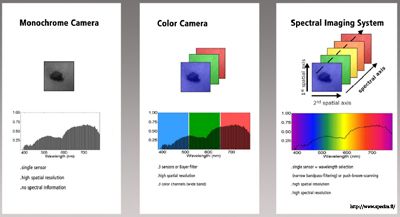The concept of multispectral imaging has been present in many applications, like Earth inspection using airborne imaging, during the last decades. However, it has not been until the last years, when the development of near infrared (NIR) high sensitivity CCD and CMOS sensors (700nm to 1000nm) and new technologies like InGaAs (900nm to 1700nm) or HgCdTe (900nm to 2500nm), has grown exponentially. This has become in the generalization of the multiespectral and hyperspectral vision concept. The key is to extend traditional image processing from the spatial domain to the spectral domain. This is possible due to the precise narrow band spectral sampling obtained from the same scene.

Nowadays, new applications of these Technologies are growing in many fields:
- Colorimetric applications, since spectral colour measurement provides significantly higher precision than traditional RGB imaging.
- Spectrographic analysis, which is based on the analysis of absorption bands in the acquired wavelengths. It is been used in chemical and pharmaceutical industry, food industry, etc.
- Quality inspection. The information present in the narrow wavelength images provides an effective way to monitor online and offline processes like fruit diseases, container inspection or electronics manufacturing.
- Remote sensing for geological applications, environmental and forestry monitoring, agriculture control or precision farming, etc.
- Medical applications like detection and monitoring of diseases, etc.
Researchers in Gradiant are working on the integration of multispectral image acquisition systems applied to face recognition. The acquisition of narrow band images in the near infrared spectrum, combined with the use of active illumination, provides a solution to reduce undesirable effects of ambient light. This brings new possibilities for developing robust face detection and alignment algorithms and provides new information to image descriptors. The conjunction use of visible and NIR spectrum provides a fusion technique to improve the performance of conventional face recognition, where Gradiant has proven expertise, captured in numerous journal and conference papers.


